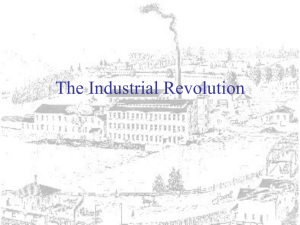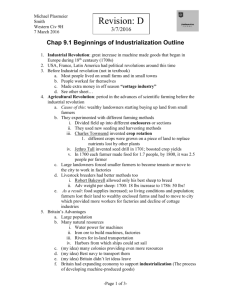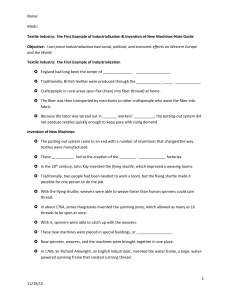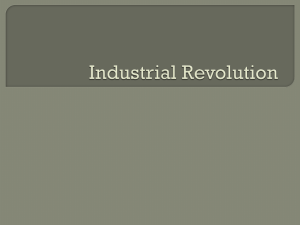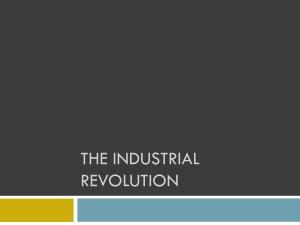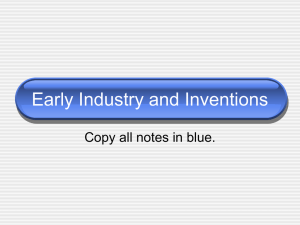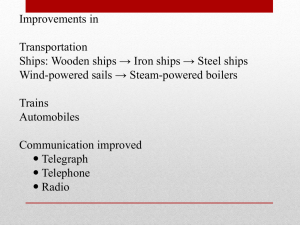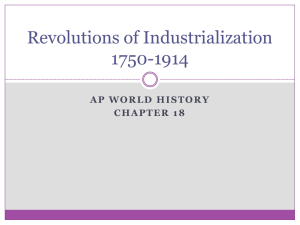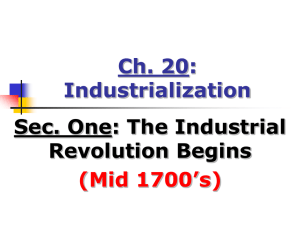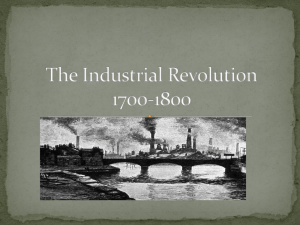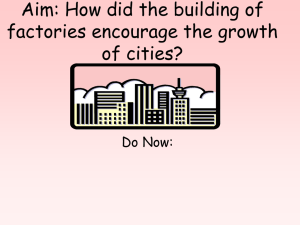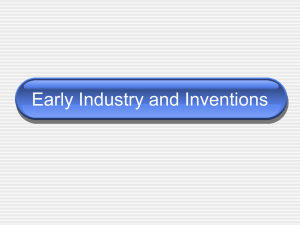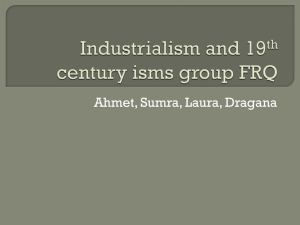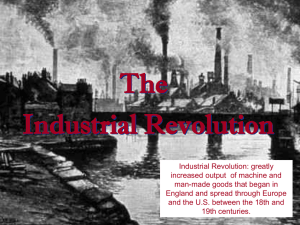The Industrial Revolution
advertisement
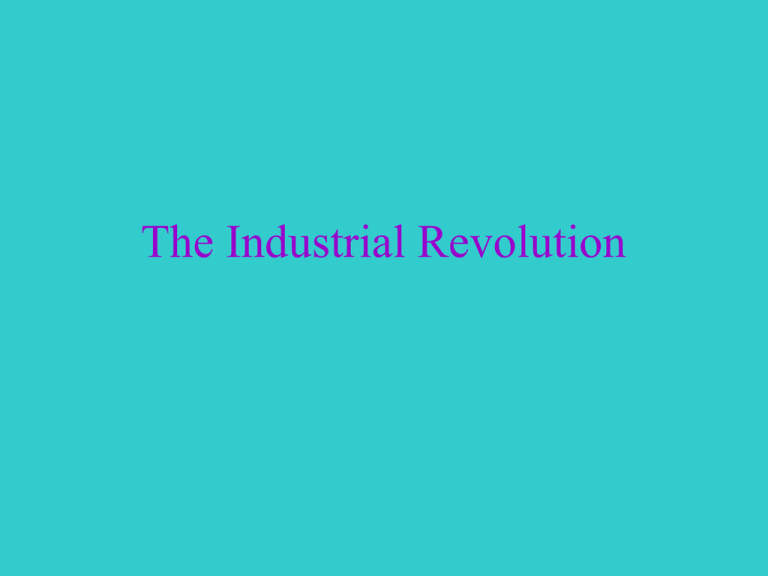
The Industrial Revolution Great Britain • Industrialization- Process of developing machine production of goods • First country to be industrialized, then spread to Continental Europe and North America • Transformed the way people worked • Machines began to do jobs that people used to do by hand Agricultural Revolution • Wealthy landowners bought up small farms and enclosed their land with fences or hedges- enclosures • Enclosures led to two things: – 1) Landowners tried new agricultural methods – 2) Large landowners forced small farmers to become tenant farmers or to give up farming and move to the cities New Methods for Farmers • Seed Drill- Invented by Jethro Tull and allowed farmers to sow seeds in wellspaced rows at specific depths • Crop Rotation- Farmers would plant different crops each year • Breeding- Farmers would only breed their best pigs, for example, so the food supply increased and people were healthier Why It Began in Britain... • • • • • Extensive natural resources Expanding economy Banking system Growing overseas trade Political stability Natural Resources • Water power and coal to fuel the new machines • Iron ore to construct machines, tools, and buildings • Rivers for inland transportation • Harbors from which merchant ships set sail Expanding Economy • Businesspeople invested in the manufacture of new inventions Banking System • People were encouraged by the availability of bank loans to invest in new machinery and expand their operations Trade • Economic progress led to the increased demand for goods • England is an island, so there are many routes to import and export Political Stability • Gave them a huge advantage over their neighbors • Although Britain took part in many wars in the 1700s, none occurred on British soil • Parliament passed laws to help encourage and protect business ventures Factors of Production • Land, labor, and capital (wealth) • Only Britain had all of these factors, which is why industrialization began in Britain Textile Industry • First industry to be transformed by new inventions • Flying Shuttle- invented by John Kay – Doubled the work a weaver could do in a day • Spinning Jenny- invented by James Hargreaves – Necessary invention for spinners because they could not keep up with weavers Textile Industry, cont. • Water Frame- invented by Richard Arkwright – Used waterpower from rapid streams to drive spinning wheels • Spinning Mule – Made thread that was stronger, finer, and more consistent than earlier spinning machines • Water-Powered Loom- invented by Edmund Cartwright – Sped up weaving, run by waterpower Factories • Water frame, the spinning mule, and the power loom were bulky and expensive machines • They took the work of spinning and weaving out of the house • Wealthy textile merchants set up the machines in large buildings called factories – Needed waterpower, so the first ones were built by rivers and streams Cotton Gin • England’s cotton came from the American South in the 1790s • Cotton gin invented by Eli Whitney to speed up the chore of removing seeds from cotton (doing it by hand was hard work) • American cotton production skyrocketed from 1.5 million pounds in 1790 to 85 million pounds in 1810 Transportation Steam Engine • Improved by James Watt in 1765 • Watt was paid by an entrepreneur to build a better machine Steamboat • The Clermont was invented by Robert Fulton in 1807 Canals • Human-made waterways that provided inland transportation • Slashed the cost of transporting both raw materials and finished goods Roads • John McAdam improved roads by using large stones topped with a layer of crushed rock • This prevented wagons from sinking in the mud • Turnpikes- Travelers had to pay a toll before going farther Liverpool-Manchester Railroad • The Rocket- hauled a 13-ton load at 24 mph--an unheard-of speed • Railway officially opened in 1830 and was an immediate success Effects of the Railroad • Spurred industrial growth by giving manufacturers a cheap way to transport materials and finished products • Created hundreds of thousands of new jobs • Boosted England’s agricultural and fishing industries • Encouraged country people to take distant city jobs Cities Urbanization • Mass movement of people to cities • Between 1800-1850, most of Europe’s urban areas doubled or quadrupled • London became the largest city in Europe – Population • Reached 1 million by 1800, and the numbers exploded after that Living Conditions • Cities grew too rapidly • No development plans, sanitary codes, or building codes • Lacked adequate housing, education, and police protection • Diseases spread • Life span was only 17 years for working class people Working Conditions • Average worker spent 14 hours a day on the job, 6 days a week • Factories were dirty • Machines injured workers • Children joined the work force as young as 6 years old – They were often beaten by factory owners for falling asleep on the job The Middle Class • Social class made up of skilled workers, professionals, businesspeople, and wealthy farmers • Usually consisted of factory owners, shippers, and merchants • Some became just as rich as the top class in society The Working Class • Unlike the middle class, they saw little improvement in their living and working conditions • These people were slowly being replaced by machines and were being put out of work • To protest, many would destroy the machines that were replacing them Positive Effects of the IR • Created jobs for workers • Contributed to the wealth of the nation • Fostered technological progress and invention • Greatly increased the production of goods • Raised the standard of living • Provided the hope of improvement in people’s lives Positive Effects, cont. • • • • Healthier diets Better housing Cheaper, mass-produced clothing Expanded educational opportunities Factory Act of 1819 • Restricted working age and hours • Many factories did not abide by this law Negative Effects • Polluted the natural environment • Coal blackened the air • Textile dyes and other wastes poisoned the rivers Industrialization Spreads U.S. • The blockade during the War of 1812 forced the U.S. to use its own resources to develop independent industries • Began in the textile industry U.S., cont. • Britain had forbidden engineers, mechanics, and toolmakers to leave the country • Samuel Slater- British mill worker who emigrated to the U.S. and built a spinning machine from memory • Moses Brown- Opened the first factory in Pawtucket, RI • Francis Cabot Lowell- Mechanized every stage in the manufacture of cloth Mill Girls • Young women flocked from rural towns to the cities • Worked 12 hours a day, 6 days a week • Although they went to gain independence, they were watched very closely by their employers inside and outside the factories Rise of Corporations • Corporation- Business owned by stockholders who share in its profits but are not personally responsible for its debts • Stock- Certain rights of ownership Large Corporations in the U.S. • Standard Oil – Founded by John D. Rockefeller • Carnegie Steel Company – Founded by Andrew Carnegie • Both of these businesses wanted to control all aspects of their own industries in order to make big profits Rise of Global Inequality • Industrialization widened the wealth gap between industrialized countries and nonindustrialized countries • Some wealthier countries did use lessdeveloped nations for raw materials • Imperialism- Policy of extending one country’s rule over many other lands – This gave industrialized nations even more power and wealth Transformation of Society • Between 1700-1900, revolutions in agriculture, production, transportation, and communication changed the way people lived in Western Europe and the U.S. • Affected everything from daily life to life expectancy • Emergence of the middle class created great opportunities for education and democratic participation Philosophers of Industrialization Laissez Faire • Economic policy of letting owners of industry and business set working conditions without interference • Favors a free market unregulated by the government • Stemmed from philosophers of the Enlightenment who believed that the economy would prosper from free trade Adam Smith • The Wealth of Nations – Economic liberty guaranteed economic progress • Three Natural Laws of Economics – 1) self-interest- people work for their own good – 2) competition- competition forces people to make a better product – 3) supply and demand- enough goods would be produced at the lowest possible price to meet demand in a market economy Capitalism • Economic system in which the factors of production are privately owned and money is invested in business ventures to make a profit Socialism • The factors of production are owned by the public and operate for the welfare of all • Socialist philosophers thought that governmental control of factories, mines, railroads, and other key industries would end poverty and promote equality • Workers would no longer be at the mercy of their employers Karl Marx • Radical type of socialism called Marxism • The Communist Manifesto – Human societies have always been divided into warring classes (“haves” v. “have-nots”, employers v. workers, bourgeoisie v. proletariat) – Believed the Industrial Revolution just made the wealth gap worse – Predicted that workers would overthrow their owners Communism • All factors of production (land, mines, railroads, factories, and businesses) are owned by the people • No private property • All goods and services would be shared equally • Marx defined this in The Communist Manifesto Effects of The Communist Manifesto • Marxism inspired revolutionaries such as Russia’s Lenin, China’s Mao Zedong, and Cuba’s Fidel Castro • These leaders adapted Marx’s beliefs to their own specific situations and needs Unions • Voluntary labor associations that speak for all workers in a particular trade • Collective bargaining- negotiations between workers and their employers • Unions bargained for better working conditions and higher pay • Strike- refusal to work if factory owners refused workers’ demands British Reform Laws • Factory Act of 1833- made it illegal to hire children under 9 years old; children ages 9-12 could not work more than 8 hours a day; young people ages 13-17 could not work more than 12 hours • Mines Act- prevented women and children from working underground • Ten Hours Act of 1847- limited the workday to ten hours for women and children who worked in factories U.S. Reform Laws • National Child Labor Committee- wanted to end child labor altogether – Argued that child labor lowered wages for all workers – Persuaded union members to join the reformers – Pressured national and state politicians to ban child labor and set maximum working hours Reform Spreads • Affected such areas as improving the workplace, extending the right to vote to working-class men, helping to end slavery, and promoting new rights for women and children • Horace Mann- favored free public education to all children • Alexis de Tocqueville- battled the brutal conditions under which prisoners lived
